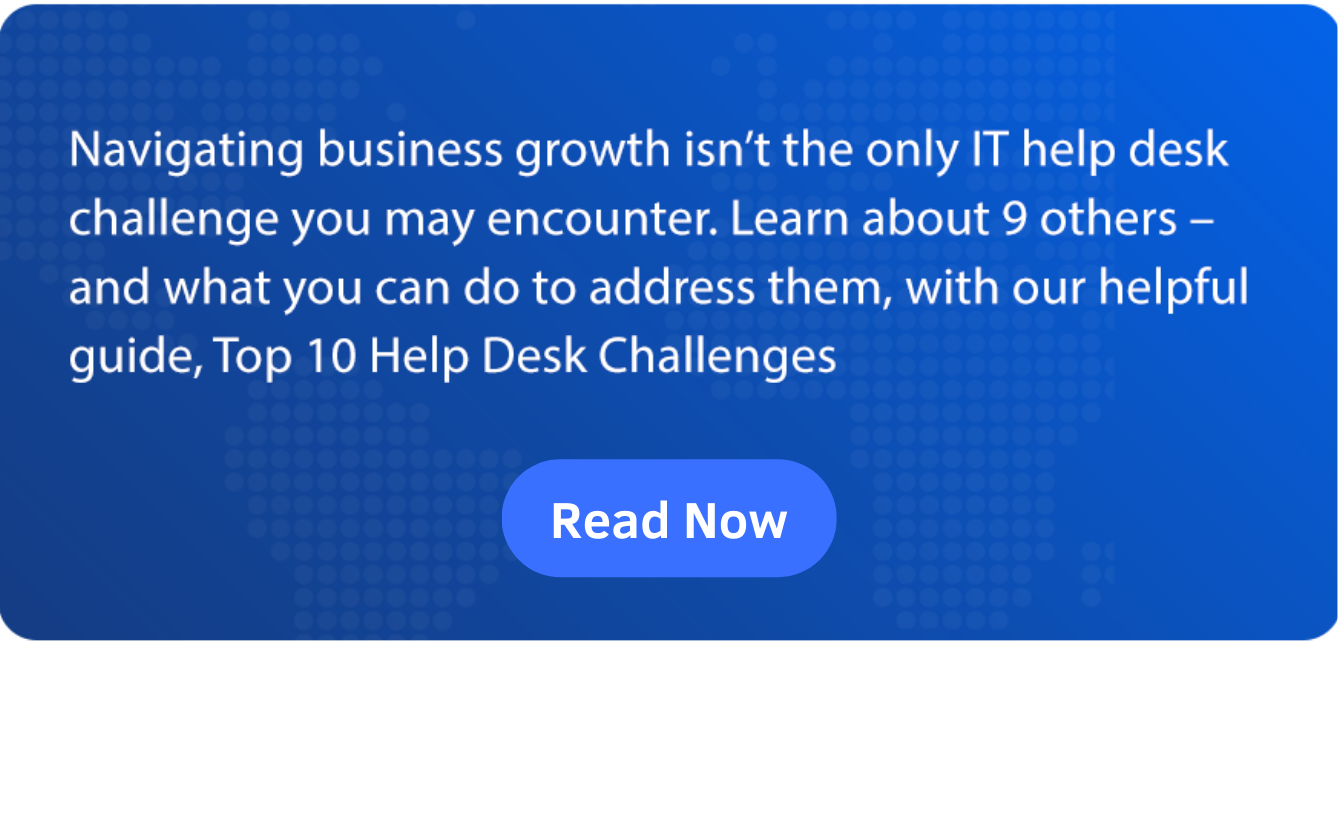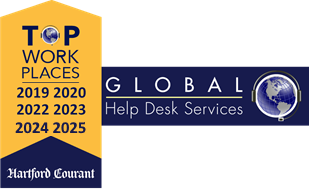A rapidly growing business puts immense pressure on the help desk. When your company expands quickly through acquisitions, expansion into new countries, or offering new products or services, your help desk might struggle to keep up with higher call volumes, evolving support issues, and plenty more.
Over the years, we’ve seen and helped plenty of IT help desks adapt, evolve, and thrive in periods of major growth.
What’s their secret? Successful IT help desks in fast-growing companies follow these seven best practices:
- Create a mini implementation plan.
- Communicate with each line of business.
- Collaborate with application owners.
- Identify what you can (and can’t) do.
- Template your training.
- Use data before deciding.
- Learn from other companies.
Read on to learn what your business should do to prepare your IT help desk as your company expands.
1. Create a Mini Implementation Plan
When it comes to preventing strain on your IT help desk, the more lead time you have, the easier it is to plan. For example, if you are going through a merger or acquisition, or if you are rolling out a new piece of software, create a miniature implementation plan. Start by identifying the reports you have available for:
- measuring and managing trends
- tracking changes in call volumes
- tracking changes in ticket volumes
- understanding the arrival patterns of calls
Your goal with this mini implementation plan is to aggregate your data and integrate it into your team so that you measure—and anticipate—the impact of anticipated growth.
2. Communicate with Each Line of Business
Clear, consistent communication is vital to managing rapid growth. Make sure you have clear communication with the business side of your company ahead of time. Don't let your IT department become an island. The more that you're working with the business on upcoming changes, the more agile you will be.
Start planning ahead of time by outlining the changes and demands you see arriving in the weeks and months ahead. Think of the information your IT help desk needs from your lines of business, and then find out what each line of business needs from your help desk. You’ll discover that some departments in your company are impacted more heavily by rapid growth than others are, and their need for help desk services will increase.
From there, keep the lines of communication open, and communicate frequently and clearly – it’s the best way to prevent roadblocks.
3. Collaborate with Application Owners
The next place you need to improve communication is with your various application service tower owner support groups.
Start by setting expectations. Let these groups know exactly what your help desk needs to know before they bring something new into the environment. Ensure that they tell you this beforehand. That way, when change does happen, you have the resources and systems in play already to accommodate these changes.
By the way, your goal with rapid change is to avoid reinventing the wheel whenever possible. Anticipate the changes you need to make in your help desk, then create predictable, repeatable processes to accommodate these changes anytime they happen.
4. Identify What You Can (and Can’t) Do
No matter what your help desk is like, there are things you can do … and there are things you can’t do. The best of intentions won’t change that.
So, when your company is experiencing growth, you must quickly identify what you can realistically accomplish. Start by identifying what your help desk can't do currently.
For example, do the calls you can’t handle currently typically come from new customers? Or are these calls related to a new service or new software being rolled out? When you receive these calls, explain to the caller that you cannot help with the issue, but then gather the essential information you need, such as who the caller is, what the application is that is causing the issue, the menu item or screen that is the problem, and so on. Then, set an appropriate expectation with the caller, and get that call moving on to the next level as quickly as possible. This way, your desk isn’t becoming a bottleneck and can resume handling more typical calls.
You may discover that, during this time of transition, you could use the services of an outsourced help desk like Global Help Desk Services, Inc. You can engage an outsourced help desk for a short-term engagement to handle the tickets that you can’t currently manage.
5. Template Your Training
One area of your operation where you can get ahead of rapid change and growth is in the classroom. So, build processes ahead of time, in anticipation of potential growth.
For example, build out a template of what a future application runbook will look like, or what a support group runbook will look like. In this template, cover the who, what, when, where, how and why of the application so that you can quickly bring that to bear in designing your training.
If the rapid growth you are anticipating involves a simple software upgrade, then re-visit your standardized training for that software. Discover what's different now with the new software versus what you were doing, append your new training to the old training, and distribute that new training to everyone concerned.
6. Use Data Before Deciding
One of the common challenges with rapid growth is managing staffing levels. Do you hire more full-time staff, or do you outsource part of your workload to a third-party help desk?
Make these decisions after looking at your data.
For example, if your company is rolling out a new piece of software, ask yourself if you already have a piece of software like it. What's the typical daily number of calls from that software based on user counts? Look at historical data for when you rolled out a different piece of software that had a similar impact on what that scale looks like.
The same goes if you're bringing on a new company. Find out from the new company what their arrival patterns and call volumes looked like, then aggregate that data into yours using the Erlang Calculator for Call Centre Staffing. See what that scaling and impact looks like to your current coverage model.
7. Learn from Other Companies
If you are rolling out a new program or a major software upgrade, reach out to the vendor for references of other companies of a similar size as yours that have gone through this sort of roll out or upgrade. Find out the challenges they faced, and the level of disruption the change caused to their IT help desk.
By talking with those other companies as a reference point, you get to gauge how what they went through impacted their environment, and then plan accordingly for yours.
Thriving—Not Just Surviving—When Growth Occurs
When you think about it, your IT help desk exists precisely because of change. Technology changes all the time. And some of your customers need help navigating that change.
But when your company expands quickly through a merger, an acquisition, an expansion into new countries or growth through new business offerings, that brings a level of change that impacts your help desk in major ways.
By implementing best practices that let you stay ahead of the change, you put your IT help desk in a position to keep succeeding without breaking stride.
If during your business growth you need help keeping up with call volumes, let’s talk. Global Help Desk Services, Inc. provides help desk outsourcing with guaranteed service levels to enterprise-sized companies around the world. As you’d expect, we’re just a phone call away, 1.800.770.1075.



